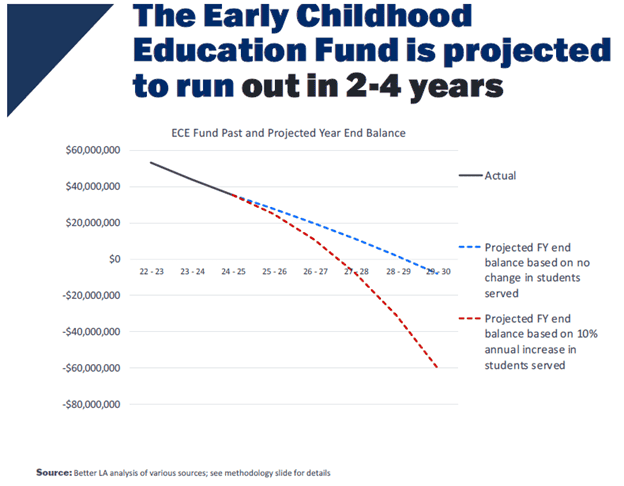Early Childhood Education Fund to Run Out of Money Soon – Leaders for a Better Louisiana

Report on the Financial Sustainability of Louisiana’s Early Childhood Education Fund
Executive Summary
A new analysis by Leaders for a Better Louisiana indicates that the state’s Early Childhood Education Fund (ECE Fund) is projected to be depleted within the next four to six years due to escalating demand from local communities. The fund, a critical tool for advancing several Sustainable Development Goals (SDGs), operates on a state-local matching basis. Its success in stimulating local investment has outpaced its recurring revenue streams, thereby exhausting its initial reserves. This report outlines the fund’s current status, future projections, and the implications for Louisiana’s progress on quality education, poverty reduction, and economic growth.
The ECE Fund’s Role in Advancing Sustainable Development Goals
Fund Mandate and Structure
Established by the Legislature in 2017, the Early Childhood Education Fund was designed to provide a dollar-for-dollar state match to local communities raising funds for early childhood education. The fund was initially capitalized with a one-time legislative appropriation of $40 million in 2023, supplemented by dedicated annual revenue streams. The objective is to leverage local investment to expand access to quality early learning, a cornerstone for sustainable development.
Alignment with Global Goals
The ECE Fund directly supports the achievement of several key United Nations Sustainable Development Goals (SDGs) in Louisiana:
- SDG 4 (Quality Education): By expanding access to pre-primary education, the fund directly addresses Target 4.2, which aims to ensure all children have access to quality early childhood development and care.
- SDG 1 (No Poverty) and SDG 5 (Gender Equality): Affordable childcare enables parents, particularly women, to enter and remain in the workforce, increasing household income and promoting economic empowerment.
- SDG 8 (Decent Work and Economic Growth): A robust early childhood education system is essential infrastructure that supports a productive statewide workforce.
- SDG 10 (Reduced Inequalities): The fund helps mitigate disparities by providing children from various economic backgrounds with foundational learning opportunities, promoting more equitable outcomes later in life.
Analysis of Fund Viability and Projections
Current Financial Pressure
The ECE Fund’s model has proven highly effective, stimulating significant local investment. Community participation has grown from four parishes raising approximately $3 million in 2022-23 to 14 parishes generating nearly $30 million today. This success has caused local draws on the fund to exceed its dedicated annual revenues, which are estimated at approximately $21 million. As a result, the fund’s one-time reserve appropriation is being rapidly depleted to meet matching obligations.
Projected Depletion Scenarios
The report from Leaders for a Better Louisiana outlines the following projections for the fund’s solvency:
- Scenario 1 (10% Annual Growth): If the number of children supported by the fund grows by a modest 10% per year, the reserves will be fully depleted by fiscal year 2027-28.
- Scenario 2 (0% Annual Growth): Even if the number of children served remains static, the fund’s reserves will only last an additional two years, until fiscal year 2029-30.
- Expenditure vs. Revenue Gap: Projected expenditure needs are expected to reach over $30 million annually with no growth and nearly $50 million with 10% annual growth by the end of the decade. This far exceeds the recurring revenue of approximately $21 million per year.
Statewide Impact and Recommendations
The Scale of Louisiana’s Childcare Needs
Access to affordable, quality childcare remains a critical issue impacting Louisiana’s progress toward the SDGs. While various public programs assist approximately 57,000 children, the state estimates an additional 116,000 children lack access. The ECE Fund has been instrumental in beginning to close this gap, having already enabled services for over 1,800 additional children by doubling the value of state investment through local matches.
Conclusion and Call for Sustainable Funding
The impending depletion of the ECE Fund threatens to reverse progress made in early childhood education and stall advancements toward SDGs 1, 4, 5, 8, and 10. The state’s Early Childhood Care and Education Commission has recommended an investment of $95 million per year over the next decade to meet statewide needs. The success of the ECE Fund’s matching model demonstrates a viable pathway to leverage state and local resources. Therefore, it is imperative that policymakers identify and secure new, sustainable funding streams for the ECE Fund. Ensuring that every local dollar raised can be matched at the state level is critical to maintaining momentum, expanding access for children, and building a more equitable and prosperous future for Louisiana.
Analysis of Sustainable Development Goals in the Article
1. Which SDGs are addressed or connected to the issues highlighted in the article?
-
SDG 4: Quality Education
The article is fundamentally about ensuring sustainable funding for “early childhood education.” This directly relates to providing quality educational opportunities from a young age, which is the core of SDG 4.
-
SDG 1: No Poverty
The article highlights that “access to affordable childcare is a critical issue for many working families” and that its cost can be prohibitively expensive. Lack of affordable childcare can be a significant barrier to employment and financial stability, thus trapping families in or pushing them towards poverty. Supporting early childhood education helps alleviate this burden.
-
SDG 8: Decent Work and Economic Growth
By providing affordable childcare, parents and guardians in “working families” are better able to enter and remain in the workforce. This supports full and productive employment, which is a key component of SDG 8.
-
SDG 10: Reduced Inequalities
The article explicitly points out a significant inequality in access, stating there are “about 116,000 additional children without access to affordable, quality childcare in Louisiana.” The Early Childhood Education Fund is a mechanism aimed at closing this gap and ensuring that more children, regardless of their family’s economic status, have the same developmental opportunities.
2. What specific targets under those SDGs can be identified based on the article’s content?
-
Target 4.2: Ensure that all girls and boys have access to quality early childhood development, care and pre-primary education so that they are ready for primary education.
The entire article focuses on the financing and provision of “early childhood education” and “quality childcare.” The goal of the Early Childhood Education Fund is to expand access to these services for more children, which directly aligns with this target.
-
Target 1.2: Reduce at least by half the proportion of men, women and children of all ages living in poverty in all its dimensions according to national definitions.
The article notes that quality childcare can be as expensive as “the cost of college.” By providing a state match to make these services more affordable, the fund directly addresses a major financial strain on low-income and “working families,” contributing to poverty reduction efforts.
-
Target 8.5: Achieve full and productive employment and decent work for all women and men.
The availability of affordable and reliable childcare is a critical enabler for parents to maintain stable employment. The article’s emphasis on supporting “working families” shows a clear link to creating conditions that allow for full participation in the labor force.
-
Target 10.2: Empower and promote the social, economic and political inclusion of all, irrespective of… economic or other status.
The initiative to serve the “116,000 additional children” who currently lack access is a direct effort to reduce inequality. Providing quality early childhood education is a proven strategy for promoting long-term social and economic inclusion by ensuring children have a strong start in life.
3. Are there any indicators mentioned or implied in the article that can be used to measure progress towards the identified targets?
Yes, the article contains several quantitative and qualitative indicators that can be used to measure progress:
-
Number of children served
The article states that “more than 1,800 additional children are being served because of the ECE Fund.” This is a direct indicator of the program’s reach and progress toward Target 4.2.
-
The gap in access to childcare
The figure of “116,000 additional children without access to affordable, quality childcare” serves as a baseline indicator of the scale of inequality (Target 10.2) and the total need that must be met.
-
Public and private investment levels
The article provides specific financial data that can be used as indicators of commitment, including the initial “$40 million” appropriation, the recurring revenue of “$21 million per year,” and the growth of local funds from “$3 million” to “nearly $30 million.”
-
Community participation rate
The increase in participating communities from “four parishes” to “14 parishes” is a clear indicator of growing local engagement and investment in early childhood education.
-
Projected funding deficits
The projections that the fund will be depleted by “fiscal year 2027-28” or “2029-30” under different scenarios act as critical risk indicators, measuring the sustainability of the current efforts.
4. Summary of SDGs, Targets, and Indicators
| SDGs | Targets | Indicators |
|---|---|---|
| SDG 4: Quality Education | 4.2: By 2030, ensure that all girls and boys have access to quality early childhood development, care and pre-primary education so that they are ready for primary education. |
|
| SDG 1: No Poverty | 1.2: By 2030, reduce at least by half the proportion of men, women and children of all ages living in poverty in all its dimensions according to national definitions. |
|
| SDG 8: Decent Work and Economic Growth | 8.5: By 2030, achieve full and productive employment and decent work for all women and men. |
|
| SDG 10: Reduced Inequalities | 10.2: By 2030, empower and promote the social, economic and political inclusion of all, irrespective of… economic or other status. |
|
Source: betterla.org
What is Your Reaction?
 Like
0
Like
0
 Dislike
0
Dislike
0
 Love
0
Love
0
 Funny
0
Funny
0
 Angry
0
Angry
0
 Sad
0
Sad
0
 Wow
0
Wow
0















































































